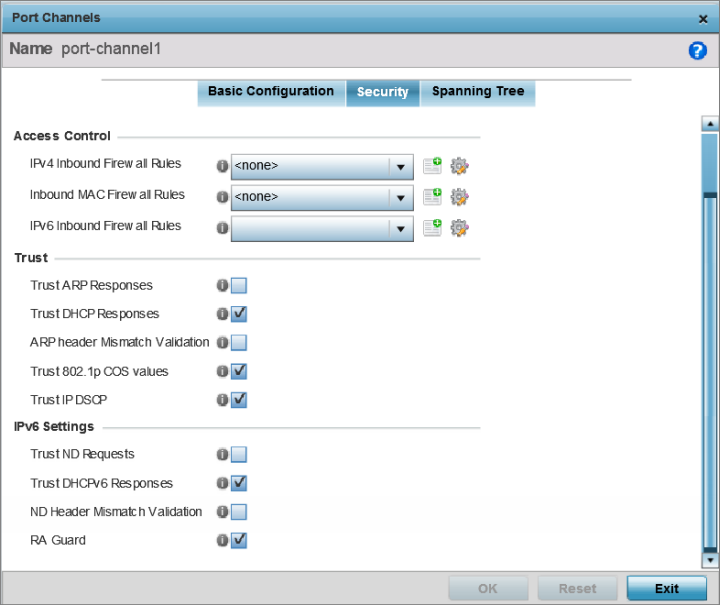To override port channel security configurations:
The port channel security configuration screen displays.

IPv4 is a connectionless protocol for packet switched networking. IPv4 operates as a best effort delivery method, as it does not guarantee delivery, and does not ensure proper sequencing or duplicate delivery (unlike (TCP). IPv4 hosts can use link local addressing to provide local connectivity.
IPv6 is the latest revision of the Internet Protocol (IP) designed to replace IPv4. IPV6 provides enhanced identification and location information for computers on networks routing traffic across the Internet. IPv6 addresses are composed of eight groups of four hexadecimal digits separated by colons.
|
Trust ARP Responses |
Select to enable ARP trust on this port. ARP packets received on this port are considered trusted, and the information from these packets is used to identify rogue devices within the network. This option is disabled by default. |
|
Trust DHCP Responses |
Select to enable DHCP trust on this port. If enabled, only DHCP responses are trusted and forwarded on this port, and a DHCP server can be connected only to a DHCP trusted port. This option is enabled by default. |
|
ARP Header Mismatch Validation |
Select to enable a mismatch check for the source MAC in both the ARP and Ethernet header. This option is enabled by default. |
|
Trust 802.1p COS values |
Select to enable 802.1p COS values on this port. This option is enabled by default. |
|
Trust IP DSCP |
Select this option to enable IP DSCP values on this port. This option is enabled by default. |
|
Trust ND Requests |
Select to enable the trust of neighbor discovery requests required on an IPv6 network. This setting is disabled by default. |
|
Trust DHCPv6 Responses |
Select to enable the trust all DHCPv6 responses. DHCPv6 is a networking protocol for configuring IPv6 hosts with IP addresses, IP prefixes, or other configuration attributes required on an IPv6 network. This setting is enabled by default. |
|
ND Header Mismatch Validation |
Select to enable a mismatch check for the source MAC within the ND header and Link Layer Option. This option is disabled by default. |
|
RA Guard |
Select this option to enable router advertisements or ICMPv6 redirects from this Ethernet port. This option is disabled by default. |
Click Reset to revert to the last saved configuration.